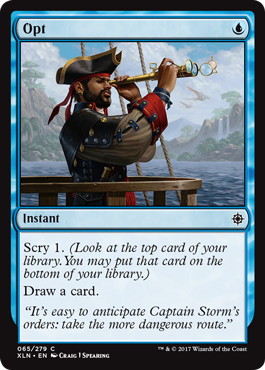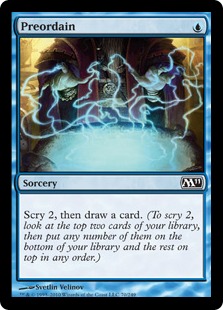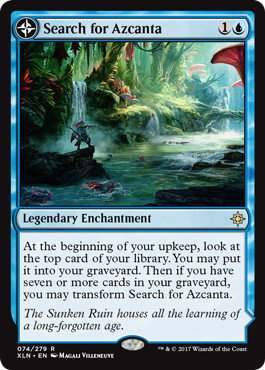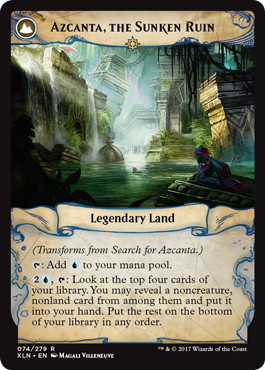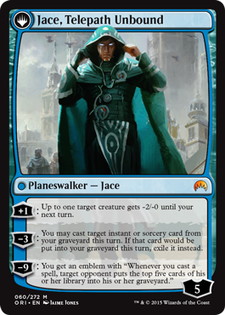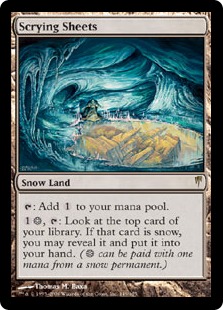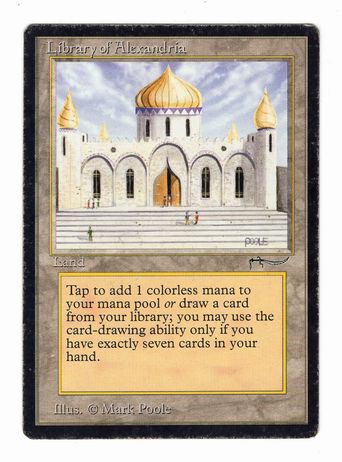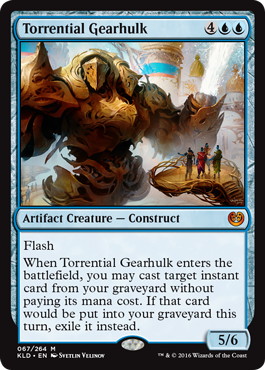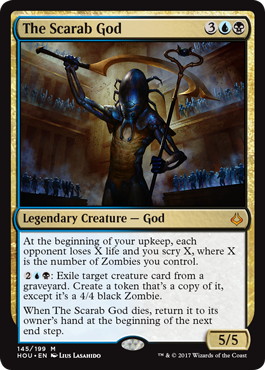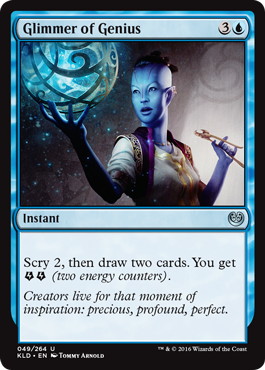Today I’d like to talk about my favorite cards from Ixalan and a possible home for them in standard.
While others are drawn to the more flashy cards and hence you will be seeing dinosaurs everywhere, I am more interested in these more innocuous cards: 《Opt》and《Search for Azcanta》.
《Opt》
《Opt》 is a reprint from invasion with a cleaned up textbox since scry is now a thing. More importantly 《Opt》 is part of a group of cards that have a tendency to dominate formats and force action by the dci: Cantrips. Other noteworthy cards in this category include 《Brainstorm》 (Restricted in Vintage), 《Ponder》 (Restricted in Vintage, Banned in Modern) and 《Preordain》 (Banned in Modern).
Obviously no one is going to concede when you play 《Opt》 as they might when you play a 《Glorybringer》 or going forward possibly a 《$Regisaur Alpha》. However what cantrips help you do is enact your gameplan more often since, for the low cost of one mana, they let you choose what you draw. Now 《Opt》 is weaker than its more famous brethren above, mostly because instead of three cards to choose from it only lets you see two. This makes its effect more similar to 《Sleight of Hand》, a card that sees Modern play.
Let us examine both the cost and the effect more closely: The cost is having to spend a blue mana at instant speed to cast this card while doing nothing to effect the board. If the way you win is to play a 1-drop into a 2-drop etc, this is going to cost you a lot since it will break up your curve. However the way Magic works is, that it is somewhat unlikely to have the lands as well as the cards to curve out perfectly every game, which is where 《Opt》 comes in. Minimizing its cost (since you would otherwise miss out on the mana if you for example have a second 2-drop on three or no 2-drop at all on two) and making it slightly more likely to find whatever you are looking for. Since 《Opt》 is an instant you can further lower the cost by playing a reactive deck where if your 2-drop is 《Censor》 for example and they dont play a spell to counter you waste less of the mana you kept up if you can cast 《Opt》 instead.
The effect is more or less straight forward: you get to look at your top card, draw it if you like it and draw the second one if you don’t. Effectively it gets you a “free” scry 1 while maintaining card parity. It is hard to quantify exactly how much a “free” scry 1 is worth however, since the exact impact on a specific game is difficult to judge. If you scry to the top you effectively did nothing while if the second card from the top is the card you needed to win the game you effectively won the game! Recent examples where the Temples from Theros or something like 《Dissolve》 and in both cases the cards saw a lot of play suggesting, that in the long run having scry 1 increases your consistency enough to make the cost worth it, if it is low enough.
My verdict would be the cost is low enough to merit the inclusion if you have a) enough blue mana to reliably cast the card early (read 14+ sources preferably 16+) while not having a gameplan that relies to heavily on curving out, preferably a reactive one.
《Search for Azcanta》and 《Azcanta, the Sunken Ruin》
The other card I mentioned, 《Search for Azcanta》, is more difficult to evaluate. First, because it is really 2 cards if you count 《Azcanta, the Sunken Ruin》, and second because there is no good comparison possible. The easiest way to judge a new card is comparing it to ones we allready know. This is usually impossible with flip cards since those are quite rare and also usually quite complex. A recent example where people had a hard time evaluating such a card was 《Jace, Vryn's Prodigy》.
So let us break this card down as best we can. One possible way to look at it is as a 《Rampant Growth》 that requires some work. Another way would be to have a scry enchantment with the bonus of putting the cards in the graveyard and possibly giving you a payoff later on, so very small recurring advantage. A third way would be to see a lategame card advantage card.
Now none of these give you a full idea, however, if you had a deck that wants all three we might have something.
“At the beginning of your upkeep, look at the top card of your library. You may put that card into your graveyard.”
This is very much like scry 1. If you have some graveyard interaction it is slightly better then scry 1. We already talked about this effect with the conclusion that it is worth it if the cost is low. The cost here is paying 1U sorcery speed while spending a card. In return you get this every turn. I believe the cost here is too high. However, there is more.
“Then if you have seven or more cards in your graveyard, you may transform 《Search for Azcanta》.”
At the very least this will transform after you didn’t want a card seven times. This is obvioulsy way to slow. Casting spells will speed this up though. 《Azcanta, the Sunken Ruin》 is a land (giving you your card back) that also has an activated ability that lets you get up on cards if the conditions are right.
《Azcanta, the Sunken Ruin》 is not a card that could see print in my opinion, as it would be way too powerful. So, having to work for it seems reasonable. Getting card advantage off your lands is a dream last seen in 《Scrying Sheets》 or 《Library of Alexandria》. You need to have a noncreature spell in your top four cards though to gain advantage. Conveniantly instants and sorceries fit the bill which also let you flip 《Search for Azcanta》more quickly since they go to the graveyard after resolution.
Assuming your deck was primarily instants, sorceries and lands I think a reasonable number of cards going to the graveyard each turn would be around 1.5. Cast one spell a turn while using Search approximately every second turn. This would let you flip it around turn five. Although you would need to cast a spell on turn one and either cast multiple spells on three and four and mill a card since you can’t cast a spell on turn two if you play 《Search for Azcanta》. If you do manage to flip it on turn five however you could say, cast a 《Torrential Gearhulk》 a turn early. Gearhulk conveniantly also wants you to play a deck with a lot of instants and blue mana.
There is another downside I have yet to mention though: Both 《Search for Azcanta》and 《Azcanta, the Sunken Ruin》are legendary. You can have one of each in play at the same time though. Still, playing four of these seems rough since at best drawing multiples will let you get another card in the graveyard to meet the flip condition and both enchantments and lands are unlikely to die. I believe the optimal number is two, since that way you will never have a dead card for long. Being able to have two of a legendary card in play at the same time is quite a boon actually.
Drawing it all together.
Both of the cards I talked about play well together and fit in the same style of deck. I have played a similar deck at Nationals and I believe this kind of deck has merit going forward. One of the more significant cards this deck lost in the rotation was 《Wandering Fumarole》, which let you play more lands while lowering the risk of flooding. However both Opt and Seach let you lower your landcount, so the fit is perfect. This is where I would start in the new format.
|
7 《Island》 4 《Mountain》 2 《Canyon Slough》 1 《Fetid Pools》 2 《Evolving Wilds》 4 《Spirebluff Canal》 4 《Aether Hub》 -Lands (24)- 1 《The Scarab God》 4 《Torrential Gearhulk》 -Creatures (5)- |
4 《Opt》 1 《Magma Spray》 4 《Harnessed Lightning》 4 《Censor》 3 《Essence Scatter》 2 《Abrade》 3 《Supreme Will》 2 《Disallow》 4 《Glimmer of Genius》 1 《Hour of Devastation》 1 《Consign // Oblivion》 2 《Search for Azcanta》 -Spells (31)- |

Thank you for reading.
Marc
Recommended Items
Share in Twitter
Share in Facebook
German powerhouse who continues to be active in Europe’s premier event and attracts attention. He is also famous as a deck builder. His construction was taken up by official coverage.
In the Pro Tour: Amonkhet, he was undefeated in the draft round, and he won the Top 8 awards with its momentum.



